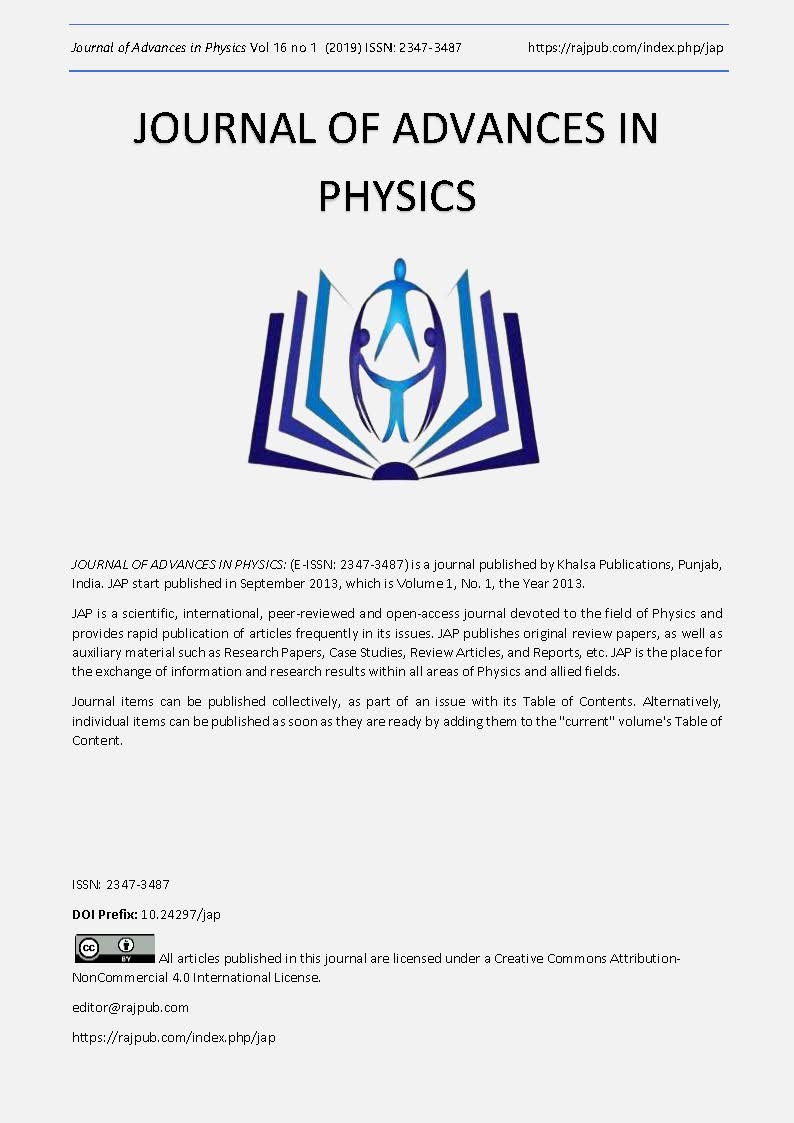Laser Induced Breakdown Spectroscopy and PIXE for Differentiation Between Different Tungsten Alloys
DOI:
https://doi.org/10.24297/jap.v16i1.8326Keywords:
LIBS, PIXE, TungstenAbstract
Tungsten is one of the hardest metals that has high melting point and high thermal conductivity. These unique properties make it suitable for many industrial applications. The increasing demand for using tungsten made the need for a fast and reliable analytical technique for tungsten to increase. In this paper we are comparing the ability of LIBS as a multi-elemental analysis technique to PIXE which is a well known established multi-elemental technique in the analysis of tungsten alloys. It was found that LIBS has the advantage over PIXE in the detection of the trace and minor elements. While PIXE is better than LIBS in the detection of major elements in the samples.
Downloads
References
A. Lissovski, K. Piip, L. Hämarik, M. Aints, M. Laan a, P. Paris, A. Hakola, J. Karhunen, J. Nucl. Mater 463 (2015) 923-926.
J. W . Davis, V. R. Barabash, A. Makhankov, L. Plochl, K. T. Slattery, Assessment of tungsten for use in the ITER plasma facing components, J. Nucl. Mater. 258 (1998) 308–312.
D. Nishijima, E. M. Hollmann, R. P. Doerner, D. L. Rudakov, Laser-induced breakdown spectroscopy analyses of tungsten surfaces, Phys. Scr. T167 (2016) 014032-014036.
G. Shaw, M. Bannister, T. M. Biewer, M. Z. Martin, F. Meyer, B. D. Wirth, The detection of He in tungsten following ion implantation by laser-induced breakdown spectroscopy, Applied Surface Science 427 (2018) 695–703.
A. Pospieszczyk, D. Borodin, S. Brezinsek, A. Huber, A. Kirschner, Ph. Mertens, G. Sergienko, B. Schweer, I. L. Beigman, L. Vainshtein, Determination of rate coefficients for fusion-relevant atoms and molecules by modelling and measurement in the boundary layer of TEXTOR, J. Phys. B 43 (2010) 144017.
B. D. Wirth, K. Nordlund, D. G. Whyte, D. Xu , Fusion materials modeling: challenges and opportunities, MRS Bull. 36 (2011) 216–222.
F. Y. Yueh, R. C. Sharma, J. P. Singh, H. S. Zhang, W. A. Spencer, Evaluation of the potential of Laser-induced Breakdown Spectroscopy for detection of trace element in liquid, Air Waste 52 (2002) 1307–1315.
G. Kim, K. Kim, H. Maeng, H. Lee, K. Park, Development of Aerosol-LIBS (Laser Induced Breakdown Spectroscopy) for Real-time Monitoring of Process-induced Particles, Aerosol and Air Quality Research 19 (2019) 455–460.
R. Fantoni, L. Caneve, F. Colao, L. Fornarini, V. Lazic, V. Spizzichino, Methodologies for laboratory laser induced breakdown spectroscopy semi-quantitative and quantitative Analysis: a review. Spectrochim. Acta B 63 (2008) 1097–1108.
E. Tognoni, V. Palleschi, M. Corsi, G. Cristoforetti, Quantitative micro-analysis by laser-induced breakdown spectroscopy: a review of the experimental approaches. Spectrochim. Acta B 57 (2002) 1115– 1130.
R.A. Rezk, A.H. Galmed, M. Abdelkreem, N.A. AbdelGhany, M.A. Harith, Quantitative analysis of Cu and Co adsorbed on fish bones via laser induced breakdown spectroscopy. Opt. Laser Technol. 83 (2016) 131–139.
R.A. Rezk, A.H. Galmed, M. Abdelkreem, N.A. Abdel Ghany, M.A. Harith, Detachment of Cu (II) and Co (II) ions from synthetic wastewater via adsorption on Lates niloticus fish bones using LIBS and XRF, Journal of Advanced Research 14 (2018) 1–9.
A.H. Galmed, A.K. Kassem, H. Von Bergmann, M.A. Harith, A study of using femtosecond LIBS in analyzing metallic thin film– semiconductor interface. Appl Phys B 102 (2011) 197–204.
A. Elhassan, A. Giakoumaki, D. Anglos, G.M. Ingo, L. Robbiola, M.A. Harith, Nanosecond, and femtosecond laser induced breakdown spectroscopic analysis of bonze alloys. Spectrochim. Acta B 63 (2008) 504–511.
G. Galbacs, N. Jedlinszki, G. Cseh, Z. Galbacs, L. Túri, Accurate quantitative analysis of gold alloys using multi-pulse laser induced breakdown spectroscopy and a correlation-based calibration method. Spectrochim. Acta B 63 (2008) 591–597.
A. Giakoumaki, K. Melessanaki, D. Anglos, Laser-induced breakdown spectroscopy (LIBS) in archaeological science applications and prospects. Anal. Bioanal. Chem. 387 (2007) 749–760.
M.E. Asgill, D.W. Hahn, Particle size limits for quantitative aerosol analysis using laser-induced breakdown spectroscopy: temporal considerations. Spectrochim. Acta B 64 (2009) 1153–1158.
E. Mal1, A. Khare, Studies on Laser produced Tungsten Plasma using LIBS, The International Conference on Fiber Optics and Photonics 2016 © OSA 2016.
D.Nishijima, Y.Ueda, R.P.Doerner, M.J.Baldwin, K.Ibano, Laser-induced breakdown spectroscopy measurement of a small fraction of rhenium in bulk tungsten, Spectrochimica Acta B 141 (2018) 94-98.
V. N. Lednev, R. S. Tretyakov, P. A. Sdvizhenskii, M. Ya Grishin, R. D. Asyutin, S. M. Pershin, Laser induced breakdown spectroscopy for in-situ multielemental analysis during additive manufacturing process, Journal of Physics: Conf. Series 1109 (2018) 012050.
A. H. Galmed, M. A. Harith, Temporal follow up of the LTE conditions in aluminum laser induced plasma at different laser energies, Appl. Phys. B 91 (2008) 651–660.
R. W. P. McWhirter, Spectral Intensities, in Plasma Diagnostic Techniques, ed. by R.H. Huddlestone, S.L. Leonard (Academic, New York, 1965).
C. Aragon, J. Bengoechea, J.A. Aguilera, Influence of the optical depth on spectral line emission from laser-induced plasmas, Spectrochim. Acta Part B 56 (2001) 619 – 628.
Downloads
Published
How to Cite
Issue
Section
License
 All articles published in Journal of Advances in Linguistics are licensed under a Creative Commons Attribution 4.0 International License.
All articles published in Journal of Advances in Linguistics are licensed under a Creative Commons Attribution 4.0 International License.




